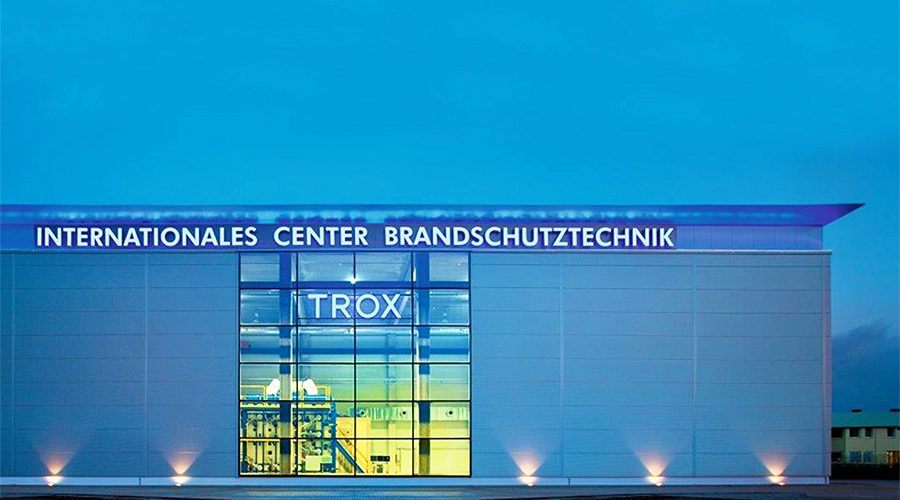Changes in safety legislation have led to multiple new guidelines, which govern the way in which buildings are constructed and maintained. The Building Safety Act, brought into law in April 2022, as well as secondary legislation and reforms to existing legislation, have changed the way in which custodians of buildings must think, both during design and after construction, says Mike Gosling TIFireE, Technical Director at TROX UK.
TROX UK
In addition to new roles and requirements for higher-risk buildings (HRBs), there are important updates in guidance regarding fire dampers in buildings of all types. For those involved in taking on these new roles or already involved in these areas, it is important to understand this technically-complex area.
In this article, I discuss key points in relation to design and construction and accountability/responsibility. I will then summarise the key topics covered by the recently-published NAAD-22 guidance document on fire dampers and the ways in which it impacts on product selection, installation and responsibilities for safety. Finally, I will review the technical assistance in relation to fire dampers available for those with responsibility for buildings.
Firstly, with regard to design and construction, under the Building Safety Act 2022, responsibilities have increased for all dutyholders, for example, individuals and organisations that commission, design, construct or refurbish buildings. Those involved must now go beyond the requirements of the Construction (Design and Management) Regulations (CDM), ensuring projects are not only safe to build, use and maintain, but also making sure they are safe to occupy.
Secondly, the act also introduced the new role of accountable person, which refers to individuals or organisations that own or have responsibility for a relevant HRB during occupation as well as individuals or organisations that are responsible for the repair or maintenance of common parts of a building, for example, corridors and lobbies. Therefore, the responsibility falls on dutyholders to select “adequate and proper materials”, that are “appropriate for the circumstances in which they are used” and to integrate these within the building design to facilitate them to be “applied, used or fixed so as to adequately perform the functions for which they are designed”. This must be achieved while ensuring that routine inspection and maintenance throughout the building’s lifetime can be achieved.
Key topics covered by NAAD-22
The NAAD-22 document covers design, selection, installation and maintenance of fire dampers. It is available for free download.
In addition to providing an overview of damper types, NAAD-22 provides guidance on minimum Regulatory requirements for routine maintenance, testing and inspection of installed dampers. It also covers the installation, testing and commissioning of dampers during initial installation, as well as considerations for the correct design and selection of fire dampers. Some key areas to study are the requirements relating to system design and damper selection, and the importance of detail and quality of workmanship during installation.
As an example, the person designing and selecting the fire dampers should understand:
1. The principles of compartmentation
2. The standards and principles for testing FDs and SCDs
3. The applications of FDs and SCDs
4. The correct procedures for the selection and installation of FDs
5. Building services spatial coordination
6. The correct procedures for access to regular testing, maintenance etc. for FDs.
7. Demonstrate good behavioural and ethical competence.
Recognition is given that the required knowledge may not be held by a single party, therefore, the involvement of a manufacturer at the early stage of design, who can support the dutyholder with respect to the certified applications of the dampers, should be considered.
In the case of a new build, once the building has been designed for compartmentalisation and the damper is being selected, the type of supporting construction into which the damper is to be installed is crucial. The manufacturer must provide a Declaration of Performance (DoP) and Installation & Operating Manual (IOM) to the dutyholder, specific to the supporting construction. Without both of these documents, there is no guarantee of performance that the installation will meet the required performance.
Failure to install a fire damper in accordance with manufacturers’ IOM, without obtaining permission for an installation deviation, will render the fire damper non compliant, with responsibility to underwrite the installation falling on those involved in this design decision. After installation, changes to the building use, which might impact upon the required damper classification, are also critical, as they could void the original installation compliance. For example, if a change in use results in a fire damper protecting an escape route, a fusible link fire damper would need to be changed to a motorised fire damper.
Technical support
Engagement with the fire damper manufacturer at an early stage is, therefore, crucial to achieve compliance. With one of Europe’s most modern fire protection laboratories, the International Centre Fire Protection Technology (ICB), TROX has developed its range of fire dampers for a wide range of supporting constructions encountered in modern buildings, from solid walls and floors to lightweight partition walls (metal and wooden stud), solid wood/CLT walls and floors, sandwich panel walls, asymmetric shaft wall, ribbed concrete and hollow deck, among others. This has resulted in third-party-notified body testing and certification of over 400 damper installations. So, we can assist those specifying dampers by providing proven, declared performance within an extensive range of supporting constructions and with multiple penetration seal options. The full accompanying installation details for the specific applications are available for an extremely wide range of mounting situations, and specifiers and contractors can be provided with the information necessary to ensure accurate selection and installation of TROX fire protection dampers. This is essential to enable those designated as dutyholders or accountable persons to achieve and maintain regulatory compliance and to safeguard building safety.
TROX has developed training seminars on fire damper and smoke control damper testing, classification and installation. TROX also supplies four fire damper variants to meet the requirements of varying system designs, all of which conform to the harmonised product standard (BS EN 15650), have been tested to BS EN 1366-2 / BS EN 15882-2 and classified for integrity (E), insulation (I) and leakage (S) to BS EN 13501-3.











